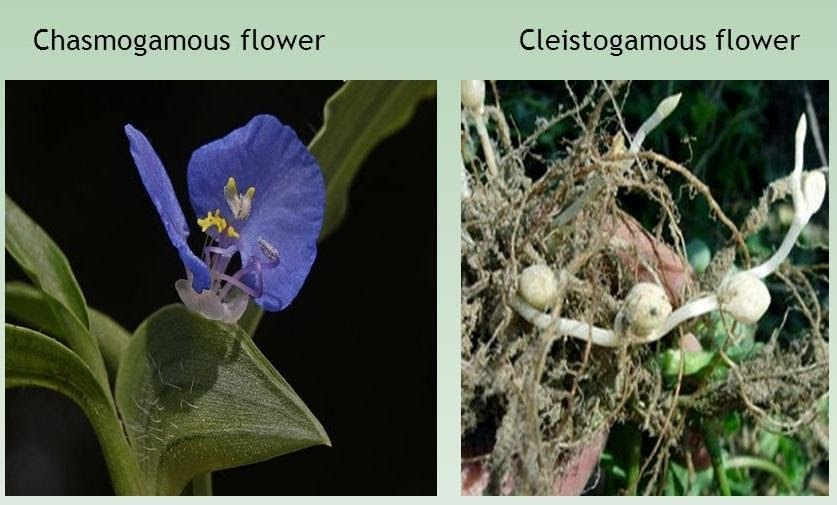
What is chasmogamous and cleistogamous?
Answer
487.8k+ views
Hint: Sexual reproduction necessitates the exchange of genetic material (DNA) between two parents. Gametes are male and female sex cells found in parent plants. To make babies, the genetic material from the male and female gametes is combined. Fertilization is the term for this procedure.
The process by which flowering plants reproduce sexually is called pollination. Male sex organs called stamens and female sex organs called pistils are found in the flowers. The pollen-bearing portion of the stamen is called the anther. When a plant's own pollen fertilises its own ovules, this is known as self-pollination.
Complete answer
Chasmogamous flowers-
Pollination happens in chasmogamous flowers, which is a plant reproductive system. Open petals enclosing exposed reproductive organs are frequent in chasmogamous flowers. Chasmogamous is derived from the Greek word chasmogamous, which means "open marriage," and refers to the open arrangement of floral structures.
Chasmogamous flowers are the sort of bloom that will only open when it has experienced "self-pollination". The flowers that don't open are the ones that don't open at all. Oxalis, Viola, peas, beans, Hibiscus, Commelina flowers, and other Chasmogamous flowers are examples.
There are two types of cross-pollination: geitonogamy and xenogamy. As a result, chasmogamous flowers demonstrate both autogamy (self-pollination) and allogamy (cross-pollination). As a result, these blooms are always autogamous since cross-pollen cannot land on the stigma.
Cleistogamous flowers-
Cleistogamy is a phenomenon in which flowers never open and only self-pollination takes place within the bud (unopened flower). Cleistogamous flowers are bisexual flowers that do not open at all. Anthers and stigma are close together in such flowers. Pollen grains come into contact with the stigma when the anthers dehisce in the flower buds, and pollination occurs.
Cleistogamy is a sort of automatic self-pollination in which certain plants reproduce by means of non-opening, self-pollinating flowers. The flowers are sexually dimorphic. Self-pollination occurs because they remain closed. Viola, Oxalis, Commelina, and Cardamine are some examples.

Note:
Difference between chasmogamy and cleistogamy
The process by which flowering plants reproduce sexually is called pollination. Male sex organs called stamens and female sex organs called pistils are found in the flowers. The pollen-bearing portion of the stamen is called the anther. When a plant's own pollen fertilises its own ovules, this is known as self-pollination.
Complete answer
Chasmogamous flowers-
Pollination happens in chasmogamous flowers, which is a plant reproductive system. Open petals enclosing exposed reproductive organs are frequent in chasmogamous flowers. Chasmogamous is derived from the Greek word chasmogamous, which means "open marriage," and refers to the open arrangement of floral structures.
Chasmogamous flowers are the sort of bloom that will only open when it has experienced "self-pollination". The flowers that don't open are the ones that don't open at all. Oxalis, Viola, peas, beans, Hibiscus, Commelina flowers, and other Chasmogamous flowers are examples.
There are two types of cross-pollination: geitonogamy and xenogamy. As a result, chasmogamous flowers demonstrate both autogamy (self-pollination) and allogamy (cross-pollination). As a result, these blooms are always autogamous since cross-pollen cannot land on the stigma.
Cleistogamous flowers-
Cleistogamy is a phenomenon in which flowers never open and only self-pollination takes place within the bud (unopened flower). Cleistogamous flowers are bisexual flowers that do not open at all. Anthers and stigma are close together in such flowers. Pollen grains come into contact with the stigma when the anthers dehisce in the flower buds, and pollination occurs.
Cleistogamy is a sort of automatic self-pollination in which certain plants reproduce by means of non-opening, self-pollinating flowers. The flowers are sexually dimorphic. Self-pollination occurs because they remain closed. Viola, Oxalis, Commelina, and Cardamine are some examples.

Note:
Difference between chasmogamy and cleistogamy
| CHASMOGAMY | CLEISTOGAMY |
| The anther and stigma of chasmogamous flowers have been uncovered. | The anthers and stigma of cleistogamous flowers remain closed and close to one other. |
| They are frequently pollinated by other species. These blooms require pollinators since cross pollination occurs. | They are frequently pollinated by other species. These blooms require pollinators since cross pollination occurs. |
| These flowers frequently contain brightly coloured petals and nectar guides to attract and reward pollinators, in order to promote cross pollination. | Pollinators do not require attractive flower parts or nectaries to be rewarded. |
| The seeds produced by chasmogamous blooms are genetically different. | These flowers establish a reliable seed set in the absence of pollinators. |
Recently Updated Pages
Master Class 12 Business Studies: Engaging Questions & Answers for Success

Master Class 12 Economics: Engaging Questions & Answers for Success

Master Class 12 English: Engaging Questions & Answers for Success

Master Class 12 Maths: Engaging Questions & Answers for Success

Master Class 12 Social Science: Engaging Questions & Answers for Success

Master Class 12 Chemistry: Engaging Questions & Answers for Success

Trending doubts
Who was the first woman to receive Bharat Ratna?

Write a letter to the principal requesting him to grant class 10 english CBSE

Why is there a time difference of about 5 hours between class 10 social science CBSE

What is the median of the first 10 natural numbers class 10 maths CBSE

The Equation xxx + 2 is Satisfied when x is Equal to Class 10 Maths

Discuss the main reasons for poverty in India




